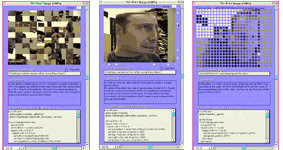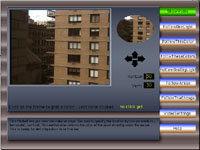|
Questions for Danny Rozin
 |
Danny Rozin is
the father of TrackThemColors, an Xtra for Macromedia Director
that many physical computing artists employ for video and
motion tracking. Core77 thought that it would be interesting
to get some extra info from Mr. Xtra.
|
C77: Could you briefly
describe your plug-in, and how it's used?
DR: The software, called TrackThemColors,
is an Xtra for Director. This means that anyone that is creating
a multimedia experience using Director can use it to enhance Director's
capabilities. The Xtra allows using live video in a variety of ways,
from merely viewing it on the stage or blending it with other graphics
to sophisticated tracking schemes that allow understanding events
in the environment and measuring activities in front of the cameras.
TTC (TrackThemColors) also allows for manipulating the live video
in real time to achieve many effects.
C77: What inspired
you to create this plug-in? What led to its development?
DR: I started messing with digital video as input to a computer
as part of my perpetual search for richer and more physical ways
for people to interact with computers. After using it for a while,
I came to the understanding that this could become a useful tool
for other people--who perhaps do not have the knowledge of programming
and computer vision--to do the coding themselves. I made it available
to the students at
ITP (Interactive Telecommunications Program NYU) where I teach,
and over the years I have expanded it's capabilities to answer many
demands and problems from tens of projects done by students at ITP.
C77: How widespread
is this plug-in?
DR: It's quite amazing how widespread TTC has become. There
is rarely a new media festival or digital art show in the past few
years that I have gone to, without seeing a few TTC projects. I
know of hundreds of people who have the software, and many more
have access to it through their universities or some affiliation
with ITP students.
C77: What is your
favorite application of the plug-in that you're aware of?
DR: I can't give a specific example, but sometimes I stumble
across a TTC project in some digital art event and I am astonished
by how different it is from the stuff I had imagined people would
be using it for, and in some cases I ask myself, how come I didn't
think of that... That makes me very proud to be part of such projects.
C77: What is the
most embarrassing application of the plug-in that you're aware of?
DR: I feel disappointed when I see projects that use the
software and are very similar to the examples I give out with it.
I feel that such projects fail to take advantage of the liberating
possibilities of vision. I am also embarrassed when I see a project
using TTC that is crippled with bugs and not responding properly.
I feel like it's my own failure.
C77: What are potential
uses of this plug-in that have not been realized?
DR: Most of the uses of TTC that I am aware of are made for
artistic expression; there are many other possibilities such as
alternative input devises for computers, assistive technology for
people with disabilities, and scientific research.
C77: Is there anything
you would like to encourage the users of your plug-in to do? Is
there strong communication between you and your users?
DR: The communication between the user and myself is usually
around technical issues and difficulties; they usually contact me
when something doesn’t work. However, many improvements to
the product have come about because of these correspondences. Some
users also contact me with links to their work to show it off.
C77: Have you attached
any intelligence to the plug-in, such as face recognition?
DR: No. I am a simple person and I believe in simple solutions
rather that AI and stuff like that. I believe there is still much
that can be done with the simple data coming in from the video feed.
That being said, I would love to know how to add something like
face recognition.
C77: Do you get credit
for this plug-in? Do you present it at conferences? Do geeks around
the world idolize you?
DR: I sometimes do get credit for the software, usually in
cases where I donate a copy to some starving student. There is certainly
a community of people that are aware of it as a possible tool for
interactive installations and this is on a hearsay basis. Most people
actually know about me from my personal artwork and are surprised
to find that I am also the person behind TTC.
C77: Why do you work
within Director? Why don't you just work in C?
DR: Director is a great tool for rapid development and creating
graphical interfaces. C, on the other hand, is a very powerful,
yet difficult, environment for rapid development. I find the combination
very powerful, and use it also for my own projects.
C77: Talk to us about
charging for your software? What are your ethics on this?
DR: I have no ethics... I sell the software online for $150-$250
(there are a few versions) and users are free to do with it as they
wish. Users that want to create commercial projects that run on
multiple computers can get a license.
C77: Do you think
the whole interactive/tracking development and appliance is kind
of stuck, or do you still see things developing?
DR: I think it is just starting. Cameras are becoming very
common, and we have barely scratched the surface with the possibilities.
Especially now that TTC is available for Windows, the networking
possibilities are opening up.
C77: How is motion-tracking
usable beyond art/design applications? Could it be used for research,
etc?
DR: Certainly. I know that similar technologies are used
in research, industry and things like marketing research where you
are trying to see how people are responding to a product.
C77: The actual interface
design of your apps is pretty bare-bones. What's your approach to
this?
DR: I tend to create simple interfaces. I find that many
computer interfaces and physical interfaces are overly complicated.
I made it my motto to always try to make the simplest thing that
will still work.
C77: What other plug-ins
have you written?
DR: Besides TTC, I also developed VideoMask, an Xtra that
uses live video and lets you add "blue screen" effects
to place the video in a different setting. Also I have BluImage
that lets you apply PhotoShop style filters to any graphic in director
and AdjustColors that lets you adjust brightness, contrast, saturation
and RGB levels of any graphic in Director.
C77: How does this
plug-in relate to the rest of your work?
DR: I use TTC, or some flavor of it in all my recent projects.
I usually end up adding a feature or two for each project, and some
of these features end up in the next release.
C77: What are some
other projects you are currently working on?
DR: Most of my recent work is based on the concept of mirrors
and reflection. I use a video camera to gather the visual information
of the viewer and the surroundings, and I create some experience,
physical or on-screen to comment on this view.
C77: What special
skills does it to take to write and distribute a plug-in? How should
today's kids get started?
DR: It takes a good idea to start from something that other
people may find useful. Once you have that, you're 99 percent done.
The rest is just learning to program in C and figuring out the overly
complicated development environment of Director Xtras, and learning
the API of the operating systems, and figuring out the cross platform
issues, and making it network capable and crushing the bugs, and
knowing that you are embarking on a non-lucrative hobby that will
take up lots of time and many tech support hours. But it's fun,
and I have enjoyed doing it for the past 7 years
>> back to the physical computing roundup
Daniel
Rozin is an artist, educator and developer working in
the area of interactive digital art. As an interactive artist, Rozin
creates installations and sculptures that have the unique ability
to change and respond to the presence and point of view of the viewer.
As an educator, Rozin is a professor and Director Of Research at
ITP, Tisch School of the Arts, NYU where he teaches such classes
as Interaction Design and Expressing with Technology, and directs
the research efforts. As developer, Rozin owns Smoothware Design,
a software company that creates tools for the interactive art and
multimedia authoring community. Born in Jerusalem and formally trained
as an industrial designer, Rozin lives and works in New York. His
work has been exhibited widely and featured in publications such
as The New York Times, Wired, Spectrum and USA Today. His work has
earned him numerous awards including Prix Ars Electronica, ID Design
Review and the Chrysler Design Award.
|





